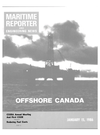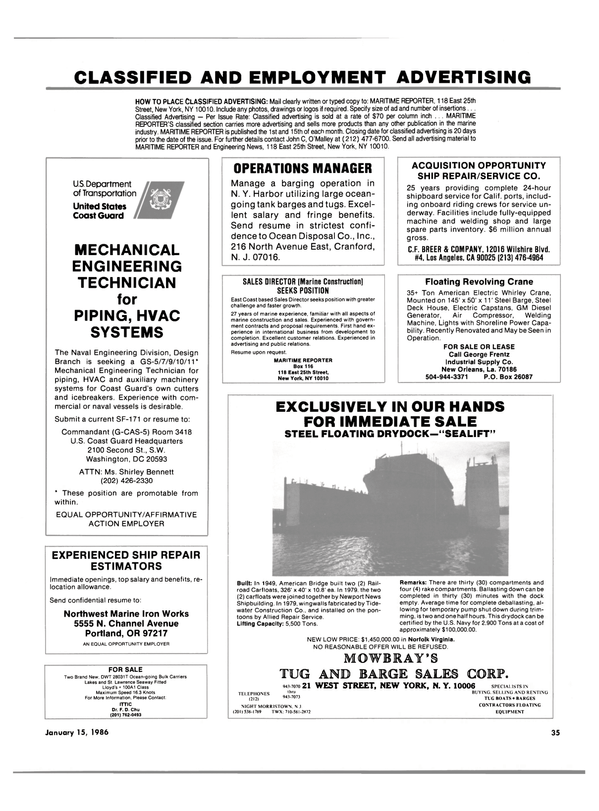
Saab Electronics Introduces TankRadar
—Literature Available Saab Marine Electronics AB of Gothenburg, Sweden, has been supplying radar-type level gauging systems for over ten years. Originally, the system's only function was to measure level. However, with the price of crude oil and refined products continually climbing, Saab realized the need for something more.
Their newest addition is TankRadar.
TankRadar is built more accurately to compute the quantity (value) of an owner's "seagoing product inventory." This result is achieved with a combination of level measurement accuracy (plus or minus 5mm over 30 meters) and cargo temperature measurement in each tank.
Level and temperature data is multiplexed from the radar transmitter to the processor unit in the control room via the same 3 pair cable. The processor takes the data, as well as an inserted cargo density figure and displays level, temperature, cargo weight and volume at the processor or on 20-inch color CRT(s). In that manner, data from all tanks and all products onboard can be computed.
By connecting an on-line printer, a total cargo manifest can be prepared quickly and with great accuracy.
Safety considerations can also be handled by TankRadar. By feeding data into a loading computer, the ship's structural integrity is always assured. Inert gas pressures and high or low level and temperature alarms for each tank can be monitored via the same CCRT(s) or at the processor.
Saab TankRadar is also capable of performing control functions.
Several systems have been installed where TankRadar is connected to cargo pumps and cargo/ballast valves. Control of the pumps and valves is accomplished via keyboard entries and CCRT monitoring. This can be set up to control digitally (on-off) or analog (0-100 percent) for both pumps and valves. The software is written in such a way that each command must be visually verified on the CCRT before it is i n i t i a t e d . That indicates the greatest possible margin of safety by always requiring operator input and always allowing operator intervention in the event of an equipment malfunction or a human error.
Recently, some very advanced systems have been offered which include the maximum automatic control. An operator can program parameters for desired cargo handling time, trim/list limits, cargo handling patterns, pumping rates, etc., and then initiate the sequence.
From there, the software will control all aspects of cargo handling within the operator-entered parameters.
Once again, the software is written with all safety considerations being given top priority. For all devices that are controlled by Saab's processor, a back-up panel can be provided. In the event of a micro-processor malfunction or a power failure, the panel will allow manual control of the connected pumps, valves, etc.
Adding capabilities has not added maintenance or repair costs. The system continues to require little or no maintenance and when repairs are necessary, they can be accomplished at the processor or from on deck. There is never a need to enter a tank and repairs are possible during any condition of loading, discharge or voyage.
In the economic climate surrounding tanker operations, any system that saves time, saves money.
If an operator can project lower operating costs he can offer a more competitive rate to a potential charterer.
If his rates are competitive enough, his ship keeps running.
Saab TankRadar offers measurement of a shipboard inventory with excellent accuracy, reliability and repairability. At the same time the system can reduce manpower requirements by using automation to any extent that the owner desires.
For additional information and free literature on Saab's TankRadar, Circle 94 on Reader Service Card
Read Saab Electronics Introduces TankRadar in Pdf, Flash or Html5 edition of January 15, 1986 Maritime Reporter
Other stories from January 15, 1986 issue
Content
- Bay Shipbuilding Expands Foreign Trade Zone page: 5
- Gladding-Hearn Shipbuilding To Build Large, Fast Passenger Catamarans On The East Coast page: 6
- Free Literature Describes New Repair Compounds From Philadelphia Resins page: 6
- ODECO Elects Kilpatrick Executive Vice President page: 6
- Combustion Engineering A w a r d e d $12 Million In Navy Boiler Contracts page: 7
- Huthnance Consolidates Management Of Nine Offshore Drilling Rigs page: 7
- Hagglunds Offers Elaborate 72-Page Full-Color Booklet On Cranes And Equipment page: 7
- Navy Ends Suspension; Tracor, Inc., Resumes Government Contracting page: 8
- ' 85 Sales Of Imperial Survival Suits Nears 100,000 page: 8
- Aalborg Yard Launches Third Reefer For Delivery To USSR's Sudoimport page: 8
- 38th Annual CSSRA Conference And First Canadian Shipbuilding & Offshore Exhibition page: 12
- $5-Billion Hibernia Offshore Project Will Get Under Way Early This Year page: 13
- Major Manufacturers Attend First Diesel Propulsion Conference Held In Seat page: 14
- Roger Nejes Appointed Assistant To President, Todd Shipyards Corp. page: 14
- Armco Continues To Upgrade Speciality Steels Facilities page: 14
- Westport Yard Building Fiberglass Passenger Vessel For TravAlaska page: 15
- Simrad, Inc. Opens U.S. East Coast Branch Office page: 15
- Balehi Marine Christens Twin-Screw Harbor Utility Boat page: 16
- Fast Sealift Ship USNS Altair Dedicated At Avondale Industries Shipyard Division page: 16
- Fincantieri Completes Major Overhauls On Two RO/RO-Containerships page: 17
- Shelley To Succeed Holmes As President Of Raytheon page: 17
- Ingersoll-Rand Purchases Fafnir Bearing Division page: 17
- McDermott Gets $48-Million Offshore Contract From Chinese Petroleum Corporation page: 18
- Pool Arctic Alaska Orders Bardex Hydranautics Island Rig Skidding System page: 18
- Bay Shipbuilding Lays Keel For Second Of Three Containerships page: 18
- Omnithrusters Delivered For Canadian Government Vessels page: 18
- Ingram Barge Completes Organization Changes— Reports Rapid G r o w th page: 19
- Optimizing Efficiency Levels Of Boiler Feed Turbo Pumps page: 20
- Russellstoll Offers Full-Color Bulletin On Heliport Lighting System page: 20
- Nichols Brothers Delivering Catamaran To Glacier Bay Yachts page: 21
- Simultaneous Drydocking Requires Separation Of 70,000-Ton Drydock At Penn Ship page: 21
- REDUCING FUEL COSTS page: 24
- BP Offers 60-Page Brochure On Facilities/Capabilities page: 28
- Farboil Offers Two Free Directories On Marine Coatings and Systems page: 28
- Todd Galveston Awarded $21.6-Million Modification Of Second T-AVB Vessel page: 28
- PNOC Marine And Bardex Hydranautics Build World Class Shipyard page: 29
- Gems Sensors Expands Line Of Level Indicators page: 29
- White Named Senior Vice President At American Systems Engineering page: 29
- Karl Senner Offers Sales And Service For Reintjes Marine Gears page: 30
- DDA Offers Expanded Product Line And Streamlined Manufacturing Facilities page: 30
- Steamship Company Chief Given Top Federal Academy Alumni A w a rd page: 31
- New Marine Overcoat Sea-Slide™ Increases Speed, Saves Fuel page: 31
- Valley Line Reorganizes And Expands Marketing Department— Three N e w Executives Join Firm page: 31
- First Lucander-Designed Tug Nozzle Built By ideal Machine page: 31
- American Metal Bearing's Rubber Bearing Staves Approved By Navy page: 32
- Brochure Explains N e w USCG Survival Suit Regulations page: 32
- Saab Electronics Introduces TankRadar page: 33
- Alden Electronics Introduces Tactical Facsimile Receiver page: 33
- Furuno Introduces Digitized Small Radar page: 33
- Offshore Triple-Effect Water Makers From Atlas-Danmark Save Thousands In Operating Expenses page: 34
- Acoustical Barrier Material Data Sheet Available page: 34
- Robertshaw Literature Describes Versatile Diaphragm Actuators page: 34
- Gladding-Hearn Delivers Two Tugs To Bermuda's Department Of Marine page: 34
- Belgian Shipbuilder "Floats7 Massive GRP Mold On Film Of Air page: 36
- Navigation Sciences Offers VIEWNAV® Master Mariner Brochure page: 36
- Bailey Offers N e w Color Brochure On Recorders And Data Loggers page: 36
- Cummins Uprates B Series Marine Diesel Engines page: 38
- Titeflex Offers 22-Page Catalog On Smooth Bore Teflon Hose page: 38
- Cincinnati Gear Offers Free Color Brochure On Large Gears And Parts page: 38
- Baldt Offers New 12-Page Full-Color Facilities Brochure page: 38
- N e w Compact Thermocoil Diesel Fuel Heater From Racor page: 43


